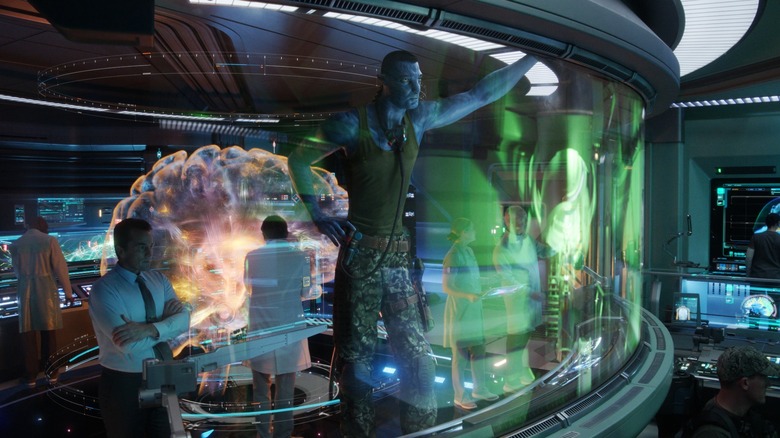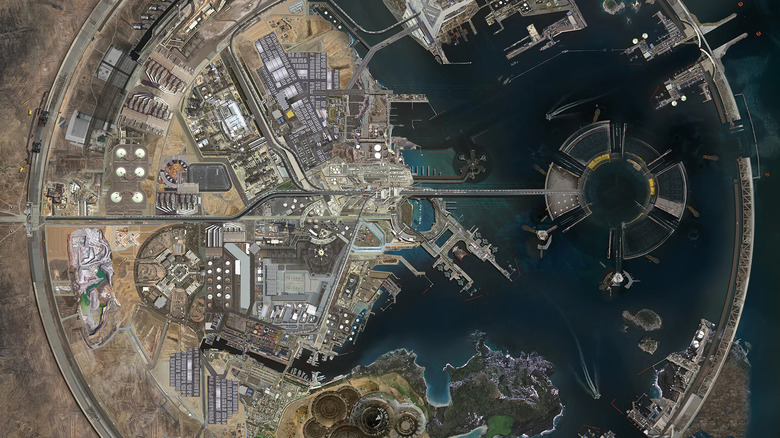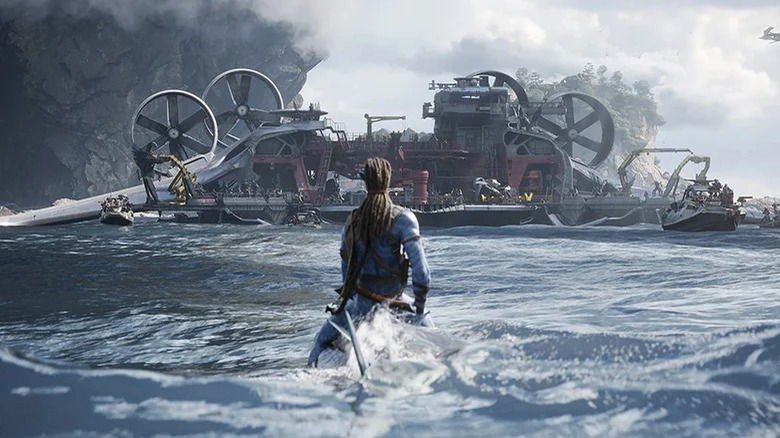'Eff You, Eywa' Was The Attitude That Drove The Design Of RDA's Bridgehead Base In Avatar: The Way Of Water
In James Cameron's 2009 film "Avatar," which takes place almost entirely on the distant planet of Pandora, several characters make passing mention that life on Earth is squalid. The implication is that poor resource allocation and rampant pollution has made our world intolerable, making it a striking contrast to the placid, glowing forests of the alien planet. It wouldn't be until an extended DVD director's cut of "Avatar," however, that life on Earth would be actually depicted on screen. Cameron's argument for Pandora as an Eden-like paradise might have stood stronger had audiences seen more of how terrible Earth actually was.
Cameron mentions the squalid Earth again in the 2022 sequel "Avatar: The Way of Water." A human military general named Frances Ardmore (Edie Falco) mentions to the resurrected Col. Quaritch (Stephen Lang) that "Earth is dying." And while humans can't breathe the atmosphere of Pandora, major terraforming measures were already underway. This exposition is given in the middle of a massive, muddy, industrial enclave being built by the human armed forces. The Bridgehead Base was cold, steely, and mechanical. It was meant to stand as a direct contrast to the glorious natural world around it. Indeed, in a shocking opening sequence, human forces drop a massive bomb on Pandora, wiping out a large portion of its forests, just so that the RDA Bridgehead Base could be built there.
According to the new book "The Art of Avatar: The Way of Water" by Tara Bennett, the design for Bridgehead was based on a very simple principle: "Eff you, Eywa." Eywa, of course, being the goddess-like consciousness that binds all life on Pandora together. It's like giving a middle finger to Mother Nature.
Bridgehead Revisited
In Bennett's book, one of the production designers on "The Way of Water," Ben Procter, describes the design of Bridgehead as being marked by dull utility. It's a big, round, metal edifice that is meant to be intimidating, and notable, visibly, anti-nature. In his words:
"Bridgehead's purpose is that of being a construction site. And it's all about humanity implying they're building a whole new city practically overnight. A sort of 'Eff you, Eywa.'"
In the world of "Avatar," 14 years have passed, meaning Jake Sully (Sam Worthington) and Neytiri (Zoe Saldaña) have begun to raise a family together ... and that Earth has become only that much more advanced. Several new technologies have been invented in that 14 years, including spindlier, more lightweight robot suits for human soldiers, and a better-equipped military. Additionally, it seems making avatar Na'vi bodies for humans is easier than it was before, and several humans now seem to occupy Na'Vi bodies permanently. Additionally, a few fleet of unusual and high-tech vehicles and guns needed to be invented, leaving Procter with an enormous task. In talking about Cameron and their mutual creative process, Procter said:
"He challenged us to create more toys in the toy box than we really needed, so there were ones that ultimately fell away. But a huge number of them didn't. And of those, he had named them already, including the Kestrel and the SeaWasp. They were on his very first list."
Later in the book, he expanded, saying:
"You could get a damn good start on a whole bunch of things in that period of time and then get feedback. [...] Each thing informs the other. And eventually, you find out what the limits of the technology are."
The history of military vehicles
In order to design the military building and vehicles for "The Way of Water," Procter looked deep into the history of military transport, looking at land craft, ocean craft, and aircraft. But because this was a sci-fi universe, he also wanted to acknowledge that the vehicles on Pandora were likely built specifically for use on that planet. "We always figured that the military technology on Pandora was somewhat customized for that planet," Procter said, "but also heavily based on Earth technology." Given that space travel has likely advanced quite a bit, there was no need to make anything lightweight or extra-portable for space travel. It's entirely likely that humans carried the pieces needed to build massive warships — or even entire already-assembled warships — to Pandora whole.
The aircraft in particular, Procter noted, were inspired by the Lockheed Martin F-22 Raptor, a high-speed jet used by the United States armed forces starting in 2005, as well as the same company's F-35 Lightning II, a type of war plane that will, according to some reports, be in use by NATO in 2030, and may remain in production until the year 2070. It seems that military builders construct their expensive machines on a very long timeline. Procter seems to have kept this in mind, saying:
"We used some of the visual motifs from those vehicles, like the stealth bone line along the side and the tinting of the canopies and of the glass and put colors into them for the Kestrel and the SeaWasp, but in different tints."
One might do well to watch "Avatar: The Way of Water" and "Top Gun: Maverick" back-to-back to see opposing views of present-day military boosterism and future-date military destruction.


